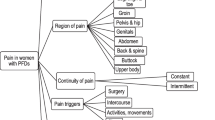Abstract
Introduction and hypothesis
Fecal incontinence treatment goals are understudied and are not described for women presenting to care. Our objective was to explore patient-reported goals for fecal incontinence management among women presenting for care at a pelvic floor disorders clinic and develop a conceptual framework that captures the range of desired treatment outcomes.
Methods
A qualitative analysis of patient-reported goals for women with fecal incontinence attending a pelvic floor disorders clinic from October 2017–November 2019 was conducted. A team-based approach was used to identify themes and emerging concepts and develop a conceptual framework.
Results
One hundred patients met the inclusion criteria. Mean age was 58 ± 14 years; 67% were White and 46% non-Hispanic. Seventy-nine percent of women had diagnosis(es) of prolapse, urinary complaints, or another pelvic floor disorder. From 230 unique goals identified, five thematic categories emerged: Emotional Status, Functional Status, Concurrent Pelvic Floor Disorders, Care Seeking, and Treatment Aspirations. Thematic domains not previously represented in other qualitative work include patients’ focus on treatment for global pelvic health rather than solely on fecal incontinence and treatment aspirations ranging from improvement to cure. Our model captures the close relationship between all pelvic floor disorders and emotion, which in return affects all facets of care.
Conclusions
Women with fecal incontinence report a range of treatment goals from improvement to complete resolution of symptoms. Focusing treatment on patient goals by addressing global pelvic health and negotiating realistic treatment outcomes may improve care in this population.

Similar content being viewed by others
References
Brown HW, Wexner SD, Segall MM, Brezoczky KL, Lukacz ES. Quality of life impact in women with accidental bowel leakage. Int J Clin Pract. 2012;66(11):1109–16.
Varma MG, Brown JS, Creasman JM, Thom DH, Van Den Eeden SK, Beattie MS, et al. Group RRfISaKRR: fecal incontinence in females older than aged 40 years: who is at risk? Dis Colon Rectum. 2006;49(6):841–51.
Sung VW, Rogers RG, Bann CM, Arya L, Barber MD, Lowder J, et al. Symptom outcomes important to women with anal incontinence: a conceptual framework. Obstet Gynecol. 2014;123(5):1023–30.
Boreham MK, Richter HE, Kenton KS, Nager CW, Gregory WT, Aronson MP, et al. Anal incontinence in women presenting for gynecologic care: prevalence, risk factors, and impact upon quality of life. Am J Obstet Gynecol. 2005;192(5):1637–42.
Gordon D, Groutz A, Goldman G, Avni A, Wolf Y, Lessing JB, et al. Anal incontinence: prevalence among female patients attending a urogynecologic clinic. Neurourol Urodyn. 1999;18(3):199–204.
Saldana Ruiz N, Kaiser AM. Fecal incontinence - challenges and solutions. World J Gastroenterol. 2017;23(1):11–24.
Rortveit G, Subak LL, Thom DH, Creasman JM, Vittinghoff E, Van Den Eeden SK, et al. Urinary incontinence, fecal incontinence and pelvic organ prolapse in a population-based, racially diverse cohort: prevalence and risk factors. Female Pelvic Med Reconstr Surg. 2010;16(5):278–83.
Kapoor DS, Thakar R, Sultan AH. Combined urinary and faecal incontinence. Int Urogynecol J Pelvic Floor Dysfunct. 2005;16(4):321–8.
Elkadry EA, Kenton KS, FitzGerald MP, Shott S, Brubaker L. Patient-selected goals: a new perspective on surgical outcome. Am J Obstet Gynecol. 2003;189(6):1551–7. discussion 1557-1558.
Thorneloe RJ, Bundy C, Griffiths CE, Ashcroft DM, Cordingley L. Nonadherence to psoriasis medication as an outcome of limited coping resources and conflicting goals: findings from a qualitative interview study with people with psoriasis. Br J Dermatol. 2017;176(3):667–76.
Manthey A, Bliss DZ, Savik K, Lowry A, Whitebird R. Goals of fecal incontinence management identified by community-living incontinent adults. West J Nurs Res. 2010;32(5):644–61.
Earp JA, Ennett ST. Conceptual models for health education research and practice. Health Educ Res. 1991;6(2):163–71.
Komesu YM, Rogers RG, Rode MA, Craig EC, Schrader RM, Gallegos KA, et al. Patient-selected goal attainment for pessary wearers: what is the clinical relevance? Am J Obstet Gynecol. 2008;198(5):577.e571–5.
Stemler S. An overview of content analysis. Pract Assess Res Eval. 2001;7(17). https://doi.org/10.7275/z6fm-2e34.
Krueger R. Focus groups: a practical guide for applied research (4th edition). Thousand Aoks, CA: Sage Publications; 2008.
Dedoose Software. Los Angeles, California; 2018. https://www.dedoose.com.
Choo MS, Doo CK, Lee KS. Satisfaction with tolterodine: assessing symptom-specific patient-reported goal achievement in the treatment of overactive bladder in female patients (STARGATE study). Int J Clin Pract. 2008;62(2):191–6.
Hullfish KL, Bovbjerg VE, Gibson J, Steers WD. Patient-centered goals for pelvic floor dysfunction surgery: what is success, and is it achieved? Am J Obstet Gynecol. 2002;187(1):88–92.
Lacima G, Espuña M, Pera M, Puig-Clota M, Quintó L, García-Valdecasas JC. Clinical, urodynamic, and manometric findings in women with combined fecal and urinary incontinence. Neurourol Urodyn. 2002;21(5):464–9.
Soligo M, Salvatore S, Milani R, Lalia M, Malberti S, Digesu GA, et al. Double incontinence in urogynecologic practice: a new insight. Am J Obstet Gynecol. 2003;189(2):438–43.
Author information
Authors and Affiliations
Corresponding author
Ethics declarations
Conflict of interest
GE Halder: Nothing to disclose.
L Caldwell: Nothing to disclose.
GG Dunivan: Nothing to disclose.
D Bilagi: Nothing to disclose.
MR Ronquillo: Nothing to disclose.
AB White: Nothing to disclose.
RG Rogers: Royalties from Uptodate, stipend and travel from ABOG and IUGA, travel and honorarium from ACOG.
Additional information
Publisher’s note
Springer Nature remains neutral with regard to jurisdictional claims in published maps and institutional affiliations.
Rights and permissions
About this article
Cite this article
Halder, G.E., Caldwell, L., Dunivan, G.G. et al. Patient-defined goals for the treatment of fecal incontinence: a qualitative analysis among women attending a urogynecology clinic. Int Urogynecol J 32, 1453–1458 (2021). https://doi.org/10.1007/s00192-020-04579-9
Received:
Accepted:
Published:
Issue Date:
DOI: https://doi.org/10.1007/s00192-020-04579-9




